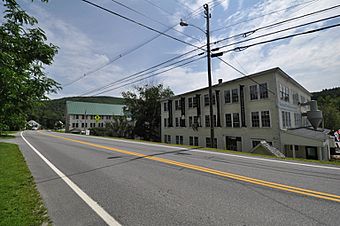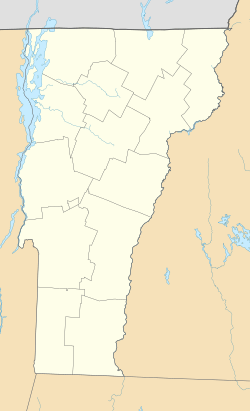Bridgewater Woolen Mill facts for kids
Quick facts for kids |
|
|
Bridgewater Woolen Mill
|
|
 |
|
| Location | U.S.4, Bridgewater and Woodstock, Vermont |
|---|---|
| Area | 6.5 acres (2.6 ha) |
| Built | 1828 |
| Architect | Southgate, Benjamin F. |
| NRHP reference No. | 76002240 |
| Added to NRHP | July 6, 1976 |
The Bridgewater Woolen Mill, now often called the Bridgewater Mill Mall, is a historic building complex in Bridgewater and Woodstock, Vermont. It's located right on United States Route 4. This old mill was a very important factory that made cloth and yarn for many years, from 1828 all the way to 1975. It was one of the longest-running textile businesses in Vermont and provided many jobs for people in the area. After it closed, it was turned into a shopping center. Because of its long history, it was added to the National Register of Historic Places in 1976.
Contents
What the Mill Looks Like
The Bridgewater Mill is a large area, covering more than 6 acres (about 2.4 hectares). It's found on the south side of US 4, right in the middle of Bridgewater village. Part of the property even goes into western Woodstock. The mill sits on a flat area next to the Ottauquechee River. This river was super important because it was the original power source for the mill.
The mill complex is made up of nine buildings that are connected to each other. Most of these buildings are made of wood, but one is made of brick. There's also a tall, separate brick chimney. The main part of the mill is a three-story building made of wood. It has a pointed roof with a square tower on top. This tower has fancy columns, like those seen in old Greek buildings.
A Look Back at the Mill's History
The land where the mill stands has been used for industry since 1786. That's when Richard and Isaac Southgate built a dam on the river. They also built a sawmill (to cut wood) and a gristmill (to grind grain).
Building the Woolen Mill
In 1825, Benjamin Southgate, who was Richard's grandson, built a new dam. Then, in 1828, he built the first textile mill on the site. We're not sure if any of the very first buildings are still standing today. This is because a big fire happened in 1852. It caused a lot of damage, so the main building we see now was likely built in 1853.
A Major Employer
The mill was a huge part of the town's life. It employed about 150 people when the town only had about 800 residents! Imagine how many families depended on the mill for their jobs.
Powering the Mill and Town
In 1909, the mill owners made an important upgrade. They added a special facility to the dam that could create electricity from the river's water. This hydroelectric power not only ran the mill but also provided electricity for homes and businesses in the village.
Challenges and New Life
The mill faced tough times during the Great Depression in the 1930s and had to close. But it didn't stay closed for long! It reopened in 1940 after some changes were made. The mill kept running until 1975, when it finally closed its doors for good.
After it closed, a group of local people bought the property. They worked to change the old mill into the shopping center it is today. This way, the historic building could have a new purpose and continue to be a part of the community.



